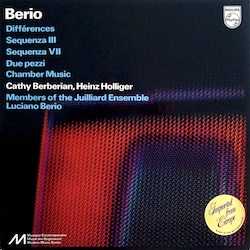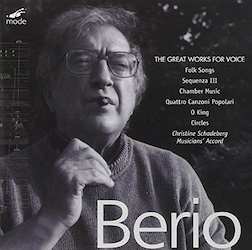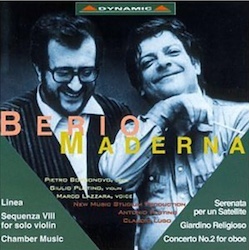Joyce Music – Berio: Chamber Music
- At October 01, 2022
- By Great Quail
- In Joyce
 0
0
As often happens to me with important encounters, I reacted to Dallapiccola with four works: “Due pezzi,” for violin and piano, “Cinque variazioni,” for piano, “Chamber Music” (setting poems by Joyce) and “Variazione,” for chamber orchestra. With these pieces I entered Dallapiccola’s “melodic” world, but they also allowed me to escape from it.
—Luciano Berio, 1985
Chamber Music
(1953)
For clarinet, cello, female singer, and harp.
I. Strings in the Earth and Air
II. Monotone
III. Winds of May
In 1953, Luciano Berio spent eight weeks studying music with Luigi Dallapiccola at Tanglewood. Italy’s foremost proponent of the Second Viennese School, Dallapiccola instructed Berio in the rigorous compositional techniques of serialism. The younger composer responded with his first true serial pieces, including Chamber Music, three settings of poems from James Joyce’s collection of the same name. A year later he would begin attending the Darmstadt Summer Course, refining his technique and blazing his own distinctive path through the knotty 12-tone woods.
Chamber Music was composed for the American mezzo Cathy Berberian, whom Berio had met in Milan and married three years before. Possessing one of the most versatile voices of the twentieth century, Berberian was the perfect vehicle for Berio’s experimentations, a role she would occupy long after their divorce in 1964.
Berio’s Chamber Music begins with “Strings in the Earth and Air,” adapted from Joyce’s “Poem I.” While all three songs are organized around serial techniques, this first sounds the most familiar to audiences accustomed to the Second Viennese School. The instrumentation is sparse, a pointillist harp scattering pitches above gliding notes coaxed from the cello and clarinet. The spacey atmosphere gently ironizes the lyrics: “Strings in the earth and air / Make music sweet.” While only the most unforgiving tonalist would deny the music has a kind of shimmering beauty, it’s decidedly unearthly, and could hardly be described as “sweet.” The vocals soar above this desultory landscape, vowels elongated into melismatic trills. The most sublime moment arrives between the second and third stanzas, where the soprano fills the space between verses with an eerie, undulating humming. The instruments increase in density, reaching a peak on “all softly playing”—another quiet irony? A miniature figure dashed from the cello like a casual hand-wave signals the end of the piece, a gentle fade to black.
As with most serial music, “Strings in the Earth and Air” is composed around intense structural principles, here involving a tone row that’s ultimately fragmented, recombined, and subjected to palindromic reversals. Of course, most of this remains invisible to the listener; yet the presence of this hidden structure creates a sense of mystery, the presentiment of an invisible hand guiding the proceedings and warding off chaos. In that way, it’s not unlike the schema of Joyce’s Ulysses, or the structure of the “Sirens” episode, which Berio would later visit in Thema.
The second song is actually Chamber Music’s penultimate poem. Unlike “Strings in the Earth and Air,” the name here is quite sincere: “Monotone.” Indeed, Berio selected the title from the heart of the poem, adding a repetition of the word in the original stanza and discarding the traditional title, “All Day I Hear the Noise of Waters.” As with the first song, there’s a hidden structure: here a serial canon of sorts, a technique Berio adapted from Dallapiccola and took to its minimalist extreme. For most of “Monotone,” the vocals declaim the lyrics on a single pitch. This A is then repeated by the instruments, creating a kind of rippling effect, the “noise of the waters.” It also—quite weirdly, as with the rows of B-notes in Sequenza VII for oboe—creates the illusion of a melody, a kind of phantom melody arising from non-pitch variations in sonic character.
Things become more exciting around “cry to the waters.” The instruments emerge from the drone in bubbling swells, explosive clusters of pizzicato, and tuning-key slides up and down vibrating harp strings. The singer’s voice intensifies, as if she’s struggling against the shackles imposed by the score. She finally breaks free on the last line, the words “to and fro” soaring with dizzy joy like birds released from a cage.
The final song is the most frenetic, the poem “Winds of May” recited by the singer above a rustle of instruments, their restless fluttering evoking the poem’s imagery of wind and seafoam. This leads to the vocal fireworks of “Welladay! Welladay!,” Berio illuminating Joyce’s archaic syllables with a burst of coloratura soprano. As the singer whispers the final line, “when love is away,” the song pauses for breath, a second of silence before a swirling coda.
Berio later claimed that Chamber Music helped “exorcise” the influence of Dallapiccola, and within a year he’d be studying with Luigi Nono and Pierre Boulez at Darmstadt. Although the record is unclear on why Berio selected James Joyce for these early settings—some sources claim Berio first read Joyce at the Milan Conservatory, other suggest it was the influence of Dallapiccola—in two years Berio was destined to meet Umberto Eco, who prompted the composer to explore Joyce’s more complex works. Berio’s next Joycean work, Thema, was also written for Cathy Berberian, but is as far away from Chamber Music as Joyce’s poetry was to Ulysses.
Liner Notes from the 1996 Dynamic CD, Berio/Maderna
Liner notes written by Mario Balma:
The record opens with Chamber Music (1953), a delightful piece for chamber ensemble and one of the first compositions Luciano Berio wrote for cathy Berberian’s multicoloured vocal means. The texts are three poems by James Joyce, whom Berio was at that time first approaching. As the composer himself declared, the model is the vocality of Dallapiccola, which inspires the first lyric, Strings in the Earth and Air, accompanied by stressed, meditative notes of the harp. The second lyric, Monotone, definitely sponges out, perfectly coherent with its title, any melodic character in the singing process which, for quite a long while, keeps bended to a sole note. The third title, Winds of May, marked by agile, floreate movements, pleasantly clashes with the “flatness” of the previous lyric and reveals a peculiar treatment of the voice.
Liner Notes from the 2006 Mode CD, Berio: The Great Works for Voice
Liner notes written by Mark Swed:
Written 15 years earlier when the composer was 28, Chamber Music may seem almost apart from either Berio’s vocal experiments or folk song settings of the 60’s. But this, too, was remarkable music for its time, and demonstrated many of the concerns that Berio would continue to pursue. Though an example of Berio’s earlier serial style, the music is nonetheless able to respond directly to the three poems from James Joyce’s early collection of the same name almost as if the music were entirely free to do so. Joyce had written these poems to be sung, and the melodic richness of Berio’s settings immediately announced that the young composer had an ear for melody that even the serial mandates of the ‘50s couldn’t dislodge.
Berio has said that in the works of this period he was reacting to his mentor, Luigi Dallapiccola. But, in fact, Berio seems top have found in his flexible response to text, voice, and instruments something more akin to a later-day Monteverdi. This is especially apparent in the second song, Monotone, with its rhythmic study on the note A. Here a single note produces, through the arresting uses of sonority, al illusion of melody where melody is impossible. Here, too, Berio demonstrates an unfailing ability to translate text into sonic theater, and he creates the sense of melody without it.
Texts
Chamber Music
I. Strings in the Earth and Air
[From Chamber Music “Poem I”]
Strings in the earth and air
Make music sweet;
Strings by the river where
The willows meet.
There’s music*,
For Love wanders there,
Pale flowers on his mantle,
Dark leaves on his hair.
All softly playing,
With head to music bent,
And fingers straying
Upon an instrument.
*Original line in Joyce: “There’s music along the river”
II. Monotone
[From Chamber Music “Poem XXXV”]
All day I hear the noise of waters
Making moan, moan, moan
Sad as the seabird is, when going
Forth alone
He hears the winds cry to the waters’
Monotone, monotone.
The grey winds, the cold winds are blowing
Where I go.
I hear the noise of waters
Far below.
All day, all night, I hear them flowing
To and fro.
III. Winds of May
[From Chamber Music “Poem IX”]
Winds of May, that dance on the sea,
Dancing a ring-around in glee
From furrow to furrow, while overhead
The foam flies up to be garlanded,
In silvery arches spanning the air,
Saw you my true love anywhere?
Welladay! Welladay!
For the winds of May!
Love is unhappy when love is away!
Recordings
 |
Berio: Chamber Music (1970)
Conductor: Luciano Berio
Musicians: Juilliard Ensemble
Soprano: Cathy Berberian
LP: Sequenza III & VII, Différences, Due pezzi, Chamber Music. Philips 6500 631 (1970)
CD: Sequenza III & VII, Différences, Due pezzi, Chamber Music. Philips 426 662-2 (1990)
Purchase: LP [Casals], CD [Amazon]
Online: YouTube
The first commercial recording of Chamber Music was part of Philips’ “Modern Music Series,” released in 1970. It featured Cathy Berberian on vocals and Berio himself conducting members of the Juilliard Ensemble, and was matched with Berio’s Différences, Sequenzas III and VII, and Due pezzi. In 1990 Philips digitally remastered the album and released it on CD with a new cover. Sadly, all Philips versions are out of print, but used copies may be obtained for under $10. There’s also numerous semi-legal pressings of this album, from obscure German releases to Russian bootlegs.
Conducted by Berio using an ensemble he established, and sung by the work’s dedicatee, this 1970 recording may be considered the definitive version of Chamber Music. Nevertheless, Berberian has a harder edge to her mezzo than most later interpreters, and heretic that I am, I prefer the 1995 Christine Schadeberg recording on Mode. (Though Berberian’s flawless “Monotone” benefits from her long association with Berio’s demanding technique.)
 |
 |
Berio: Chamber Music (1993)
Conductor: Jürg Henneberger
Musicians: Ensemble für Neue Muzik Zürich
Mezzosoprano: Hedwig Fassbender
CD: Berio: Folk Songs, Chamber Music; Denissow: La vie en rouge. Jecklin-Disco JD684-2 (1993)
CD: Berio & Denissow: Works for Voice and Chamber Ensemble. HATNOWART168 (2009)
Purchase: CD [Amazon], Digital [Amazon | Presto Music]
This 1993 recording was originally released on CD as Jecklin-Disco JD684-2. It was remastered by Peter Pfister and reissued in 2009 as HATNOWART168. Fassbender offers a solid interpretation, and is particularly strong on “Winds of May,” flinging herself into the poem with excitement and urgency.
Berio: Chamber Music (1995)
Musicians: Musicians Accord
Soprano: Christine Schadeberg
CD: Berio: The Great Works for Voice. Mode #48 (1995, remastered 2006)
Purchase: CD [Amazon.com | Mode Records], Digital [Presto Music]
A lovely edition from the always-reliable Mode, this is a must-own CD, and contains a treasure trove of Berio’s vocal writing including Folk Songs, Sequenza III, Chamber Music, Quattro Canzoni Popular, O King, and Circles. The performance of Chamber Music was recorded on 3 April 1995 at Sheppard Hall, City College of New York, and features Christine Schadeberg. She sings marvelously, her voice more soft and buttery than Berberian’s, but mastering the many expressive fluctuations demanded by the score. While the Berberian recording may be considered definitive, this should be anyone’s second choice.
Berio: Chamber Music (1996)
Musicians: Clarinet—Lucia Rosati; Cello—Giovanni Scaglione; Harp—Alessandra Magrini
Alto: Marco Lazzara
CD: Berio/Madaerna. Dynamic CDS-174 (1996)
Purchase: CD [Amazon], Digital [Presto Music]
Online: YouTube
This CD combines works by Luciano Berio and his contemporary, Bruno Maderna. What’s particularly interesting about this recording of Chamber Music is the choice of vocalist—the countertenor Marco Lazzara, who’s listed as an “alto.” Countertenors have always occupied a special place in Western music, often signifying the strange, exotic, or unearthly; when combined with Berio’s serial score, the result is even more “otherworldly” than usual. Lazzara’s alto brings a darker sound color to the pieces, and the musicians echo this dampened quality by playing with subtlety and restraint. The demands Berio places on the vocalist result in some delicious ambiguities and surprising moments regarding traditional gender roles in classical song, especially when Lazzara’s more “masculine” recitations erupt into more “feminine” vocal stylings. It’s a unique interpretation and one worth hearing!
Online Video
The following live performances are available on YouTube.
Chamber Music
Mezzo-Soprano: Helena van Heel; Clarinet: Nancy Braithwaite; Cello: Matthias Naegele; Harp: Marleen de Bakker
Recorded 26 April 2018 at the Uilenburger Synagogue in Amsterdam, this is a lovely performance, even if the video is low-definition. It’s clear these musicians have a deep appreciation for the score, and the look on Helena van Heel’s face at the end of “Strings In the Earth and Air” is priceless—a slightly-startled “I think we actually pulled that off!” like someone who narrowly avoided an accident.
Additional Information
“Berio’s Early Use of Serial Techniques: An Analysis of Chamber Music”
This paper, a masters thesis by Nicholas Jurkowski, takes a deep dive into Berio’s Chamber Music. A paper written by a composer and intended for composers, Jurkowski’s analysis is not for the faint-hearted! Nevertheless, it offers some interesting information, even for non-musicians such as myself. [PDF]
Chamber Music Recording and Score
This YouTube video features the 1999 Mario Lazzara recording and a scroll of Berio’s score.
Luciano Berio: Other Joyce-Related Works
Luciano Berio Main Page
Return to the Brazen Head’s Luciano Berio profile.
Thema (Omaggio a Joyce) (1958)
An electronic transformation of the opening text from the “Sirens” episode of Ulysses read by Cathy Berberian.
Epifanie (1961/65)
A variable sequence of orchestral and vocal pieces, including texts from A Portrait of the Artist as a Young Man and Ulysses.
Traces (1964)
Only given one performance and withdrawn, this “ghost opera” about racism was partially inspired by the “Circe” episode of Ulysses.
Sinfonia (1968/69)
This tour de force of music, voice, and sound incorporates text from Samuel Beckett’s The Unnamable. While it has no overt Joycean references, Sinfonia is frequently compared to Ulysses and Finnegans Wake.
A-Ronne (1974/75)
A “documentary” on a poem by Edoardo Sanguineti, this piece of vocal virtuosity contains a reference to Finnegans Wake.
Outis (1996)
Berio’s opera about the transformations of Odysseus includes material borrowed from Joyce’s Ulysses.
Author: Allen B. Ruch
Last Modified: 20 June 2024
Joyce Music Page: Bronze by Gold
Main Joyce Page: The Brazen Head
Contact: quail(at)shipwrecklibrary(dot)com



